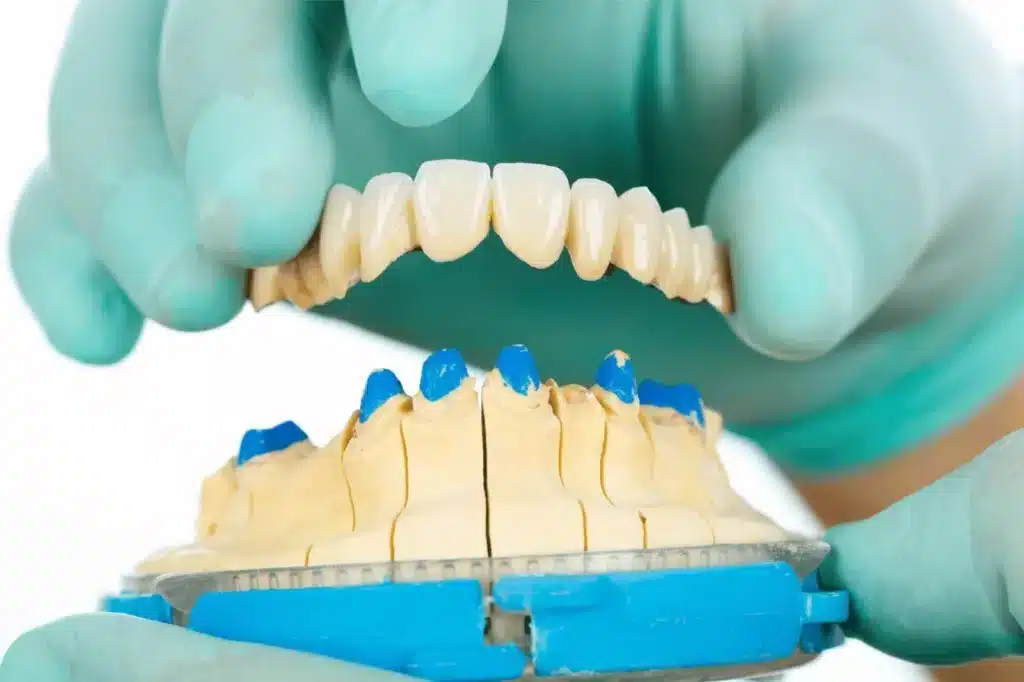Do you know the difference between dental crowns and bridges? Here’s a solution. Read to know how dental crowns and bridges work.
Both dental crowns and bridges enhance your smile’s appearance. Each one has its pros. Let’s explore both dental crowns and bridges.
Dental Crowns
A crown, also called a cap, is like a cover for a tooth. It replaces the tooth’s outer enamel layer and looks and works like a natural tooth. Crowns can be made from different materials, like plastic, metal, porcelain, or a mix, each with advantages and drawbacks.
Types of Crowns
Crowns are like covers for teeth, and they can be made from different materials, like plastic or metal. Each type has its pros and cons.
Plastic Crowns
These are used as temporary caps while a permanent one is being made. They’re cheap but only last a short time, so they can only be a temporary fix.
Full Metal Crown (Yellow Gold)
These are good for very short back teeth that are short. They don’t need much of the tooth to be removed, last a long time, and resist decay well, but they don’t look very friendly and are costly because of the gold.
Porcelain Fused to Metal Crown
- It can be used for any tooth.
- It looks natural, lasts long, and is strong.
- It can show a dark line near the gum where the metal is, doesn’t look entirely like a natural tooth, and the porcelain can break.
All Porcelain Crowns
- They are usually used for front teeth.
- It looks the most like a natural tooth and is pleasing to the eye.
- It requires more removal of the original tooth, which can break easily if you grind your teeth.
Zirconia Crown
- It can be used for any tooth.
- It looks natural but less than all porcelain. It’s good at hiding the dark color of a discolored tooth and is very strong.
- It’s a newer material with little long-term data and can cause damage to the tooth it bites against.
Why do Teeth Need Crowns?
Both dental crowns and bridges are needed depending on your needs. Teeth need crowns when they’re not strong enough to handle regular chewing. Here are the main reasons:
Large Cavities: If a tooth has a big hole (cavity) that has eaten away most of the tooth, it can’t hold a regular filling. So, a crown is like a cap that covers and strengthens the tooth, letting it work properly.
Large Fillings: When a tooth already has a big filling covering more than half of the tooth, the rest can become too weak. A crown makes it stronger and helps it last longer.
Cracks: Sometimes, teeth develop cracks. If a crack isn’t too severe, a crown can prevent it from worsening. It’s like replacing the tooth’s protective coat (enamel) with a crown to keep it safe.

Root Canal: A tooth loses nourishment and becomes brittle after a root canal. This makes it prone to cracking. To prevent that, a crown is placed over the tooth to keep it strong and avoid further damage.
In simple terms, crowns are like protective caps that strengthen weak or damaged teeth again.
Dental Bridge
A bridge is like a fixed denture, which means it’s attached (glued) to your teeth. It’s used when you’re missing a few teeth but still have good teeth on both sides of the space.
The bridge has two parts: the “retainers,” which are like crowns and cover the teeth next to the space, and the “pontic,” a fake tooth that goes in the space.
If you’re missing just one tooth, the bridge has three parts: one for each excellent tooth next to the space and one for the fake tooth in the middle. Bridges can be made from the same stuff they use for crowns, like different materials.
Benefits of a Bridge
Dental crowns and bridges both have benefits depending on the oral situation. Let’s explore the pros of getting bridges.
- A bridge is a quick solution to replace 1-2 missing teeth.
- They are usually covered by dental insurance.
- No need for surgery.
- Only two visits to the dentist are needed.
Disadvantages of a Bridge
- Cleaning a bridge is harder than cleaning separate teeth.
- You might need special tools to clean underneath the bridge.
- It takes extra effort to keep it clean and free from cavities.
- Sometimes, healthy parts of adjacent teeth must be removed to make the bridge.
Alternatives to a Bridge
Removable Partial Denture
- This is a denture that you can take in and out.
- It’s not glued to your teeth.
- It rests on nearby teeth with a metal or plastic base to hold the fake teeth.
Dental Implant
- This is the most expensive option.
- It’s like a fake tooth that’s securely placed in your jawbone.
- It doesn’t rely on or impact the nearby teeth.
- It gives a very natural result.
Conclusion
The blog guides you on dental crowns and bridges. Hope now you know what you require, depending on your needs. Consult your dentist before getting dental procedures.
Contact Dentalsway for more details on dental crowns and bridges.


